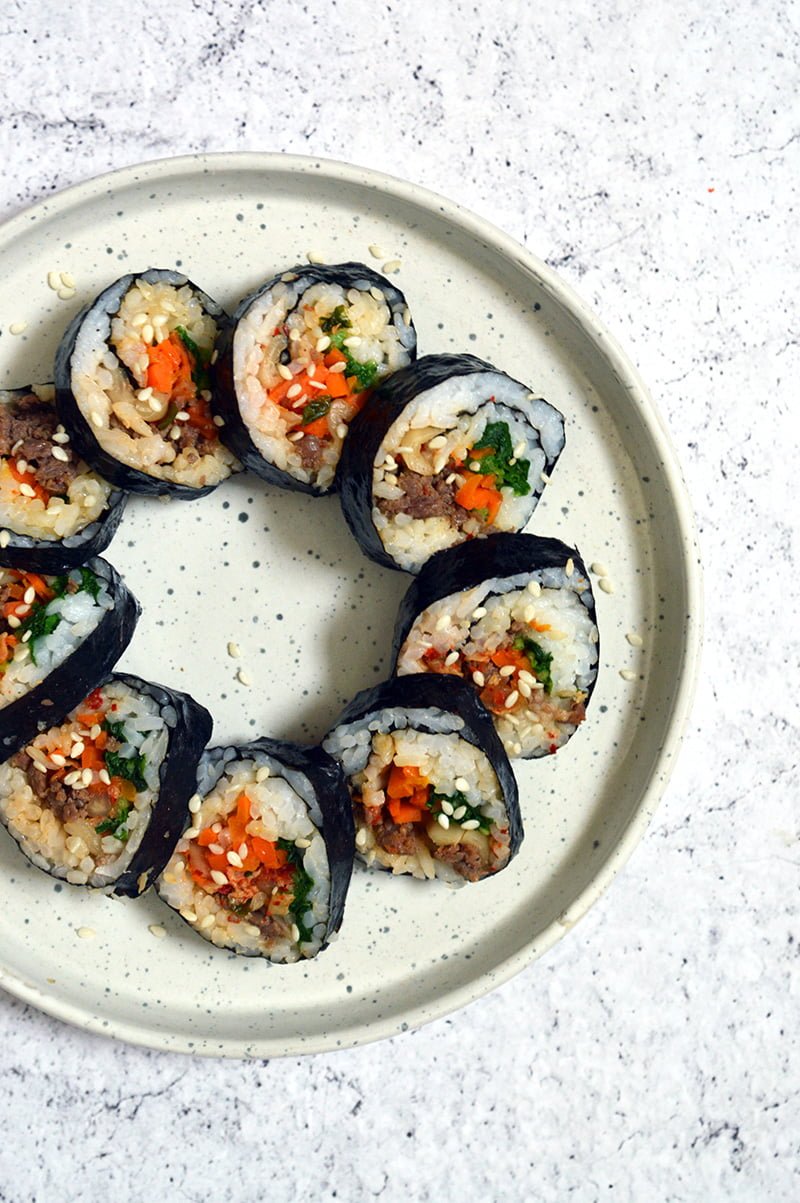Kimchi Kimbap
This post may contain affiliate links. Please read my disclosure policy for details.
Kimchi Kimbap (김치김밥) is literally a seaweed rice roll filled with a variety of delicious fillings, which features kimchi as the main filling.

Kimchi and kimbap are two essential food for Korean people. Kimchi played a huge part in Korean cuisine as it is used at almost every meal either as an appetizer, a side dish, or an ingredient for cooking. Meanwhile, kimbap is associated with everyday food because it is nutritious, portable, and versatile Hence, it usually shows up during picnics and school field days. They are pretty much everywhere in Korea.
You can definitely make your own signature kimbap by adding your favorite ingredients, or by making different shapes. It is also fun to add a special ingredient to give a different twist to the original kimbap, just like this Kimchi Kimbap recipe. This version uses delicious fermented kimchi to give a tangy, umami, and refreshing taste instead of using danmuji, the essential ingredient in making good kimbap. In addition, the spicy and crunchy kimchi also adds a wonderful texture to the kimbap. If you are searching for original and authentic kimbap, check out my previous Kimbap recipe.
What Fillings Go With Kimbap?
The beauty of kimbap rolls is you can customize them with your preferred ingredients, as long as you can stuff and roll them up into beautiful cylinders. Here are some common filling ingredients used for kimbap;
- Rice: short-medium rice grain, brown rice.
- Protein: bulgogi/ground beef, chicken, egg, ham, tuna, fish cake, imitation crab, cheese.
- Vegetables: kimchi, carrot, spinach, zucchini, cucumber, burdock root, danmuji/pickled radish
, daikon.
Tips for Making Kimchi Kimbap
Once you have all the ingredients prepped, the assembling goes by pretty quickly, and it’s worth it because it’s like having a well-balanced meal in every bite. Here are some tips for making Kimchi Kimbap.
1. Squeeze out kimchi juice
Kimchi’s flavor is pretty complex depending on the vegetables, length of fermentation, and the amount of salt or sugar used. The main flavor notes you will find in kimchi include sour, spicy, and umami. Because kimchi is a fermented dish, it has a prominent sour flavor as the lactic acid produced by bacteria during fermentation, creating a tangy and pungent flavor.
Although there are many varieties of kimchi, this napa cabbage kimchi or baechu-kimchi (배추김치) is arguably the most common and popular variety used in kimbap. You can find many kimchi brands in the refrigerator section at your local supermarket that varies wildly in appearance, texture, and taste. Sometimes I find them tasty to my liking, but others are too salty, vinegary, or sour they will make you pucker. After a series of disappointments, mostly because the store-bought kimchi did not have the taste I wanted, I usually make my own Napa Cabbage Kimchi.
As kimchi is somewhat wet, I like to squeeze the juice out of the kimchi when measuring so that it does not make kimbap soggy. After that, I chop it into smaller pieces to make the rolling process easier.

2. Use freshly cooked rice
Freshly cooked rice is the best for making kimbap because it tends to stick easier to the seaweed. Wet your fingers before spreading the rice onto the seaweed to prevent the rice from sticking to your hands. Put a small bowl of water next to your rolling station so that you can wet your hand in between rolls.
3. Season everything
Traditionally, the rice and fillings in kimbap are individually seasoned to give an interesting combination of textures and flavors. For the rice, it is traditionally seasoned with sesame oil and salt. You will notice a huge different flavor between the seasoned and unseasoned rice. The seasoned rice really takes plain rice to tasty heights.
For the meat, I marinate it with soy sauce, sesame oil, sugar, and garlic. Meanwhile, the vegetables usually are blanched or stir-fried lightly to retain their original flavor. Then, they are seasoned with a small amount of sesame oil and salt just to give them a nutty flavor and savory notes. You do not need to dip kimbap into any kind of sauce after everything is seasoned well.

4. Roll kimbap tightly
It takes some practice to roll the kimbap perfectly. Use a bamboo sushi roller or a piece of tin foil to roll them easily. Lay the shiny side of seaweed down and spread the rice, leaving the top 1-2 inches bare. Lay the fillings about a third of the way up from the bottom of the seaweed. Then, roll from the bottom and press down to make the fillings stay in. As you continue to roll, put the whole thing down toward the end of the bamboo mat. Just remember to roll it tightly by putting firm, even pressure with your hands all over the roll. Spread a tiny dab of water along the top seam to hold the roll together.

5. Brush kimbap with sesame oil
Rub or brush the roll with a little bit of sesame oil for an extra nutty flavor and shiny look. This process also makes it easier to cut. Then, use a sharp knife for cutting your rolls. You need to make a clean slicing motion without pressing on the roll or everything will fall apart. Occasionally wipe the knife with a wet paper towel or cloth to clean the starch off and to ease the cutting process.
6. Make bibimbap with leftovers
I tend to leave a lot of leftovers when making kimbap. Simply put the leftovers on top of a bowl of steaming rice, add gochujang sauce and mix them all together into Bibimbap.


More Korean Recipes
If you don’t know, I have tons of delicious Korean recipes here for you to try:
- Kimchi Fried Rice
- Tuna Kimchi Pancakes
- Kimchi Pancake
- Dakgangjeong (Korean Fried Chicken)
- Hotteok (Sweet Korean Pancakes)

Ingredients
- 5 sheets nori seaweed
- 4 cups freshly cooked short-medium white rice
- 2 tsp sesame oil
- 1/2 tsp salt, or more for taste
- Sesame oil, for serving
- Toasted sesame seeds, for garnish
Vegetables
- 1 cup (225 gr) Napa Cabbage Kimchi
- 1 bunch spinach, stems removed
- 1 medium carrot, julienned
- 1 tsp sesame oil
- 1/2 tsp salt, or more for taste
- Vegetable oil
Marinated Beef
- 0.5 lbs (250 gr) bulgogi/ground beef
- 1 tbsp soy sauce
- 2 tsp sesame oil
- 1 tbsp granulated sugar/brown sugar
- 1/2 tsp minced garlic
- Vegetable oil
Instructions
Rice
- Place freshly made rice in a large bowl. Gently mix salt and sesame oil over top with a rice scoop. Let it cool down enough so it’s no longer steaming. Cover and set aside.
Vegetables
- Bring a large pot of water to a boil over high heat and prepare an ice bath. Blanch the spinach, place immediately in the ice bath, then squeeze out water. Season with 1/2 tsp sesame oil and 1/4 tsp salt. Set aside.
- Combine the carrot matchsticks with 1/4 tsp salt. Mix well and let it sweat for 5-10 minutes. Heat a pan and add a few drops of vegetable oil. Squeeze out excess water from the carrot, then saute for about 1 minute. Stir in 1/2 tsp sesame oil. Set aside.
- Squeeze out kimchi juice with hands. Chop the kimchi into smaller pieces. Set aside.
Marinated Beef
- Marinate the beef with soy sauce, sesame oil, sugar, and garlic.
- Heat up a pan over medium-high heat and cook the marinated beef until well cooked. Set aside.
Assemble
- Place a sheet of nori on a bamboo mat with the shiny side down. Spread evenly about 3/4 cup cooked rice over the top, leaving about 1 inch uncovered on top of the nori. Place beef, kimchi, carrot, spinach in the center of the rice.
- Use both hands to roll the mat over the fillings. Remove the roll from the mat. Repeat 4 more times with the remaining ingredients.
- Brush sesame oil on the finished rolls and sprinkle some sesame seeds over the top. Cut each roll into 1/4 inch bite-size pieces with a sharp knife, occasionally wiping it with a wet paper towel or cloth to clean the starch off and to ease cutting. Put it on a plate and serve immediately or pack it in a lunchbox.







Made these tonight and they cured my craving for kimbap! I tagged you on Instagram too.
Thanks for the recipe, amazing tips.
Especially squeezing out the kimchi juice, it does make things neater.
And seasoning the rice, which I often forget.
This is so easy to understand. I will definitely try this recipe
This is so easy to understand. I will definitely try this recipe